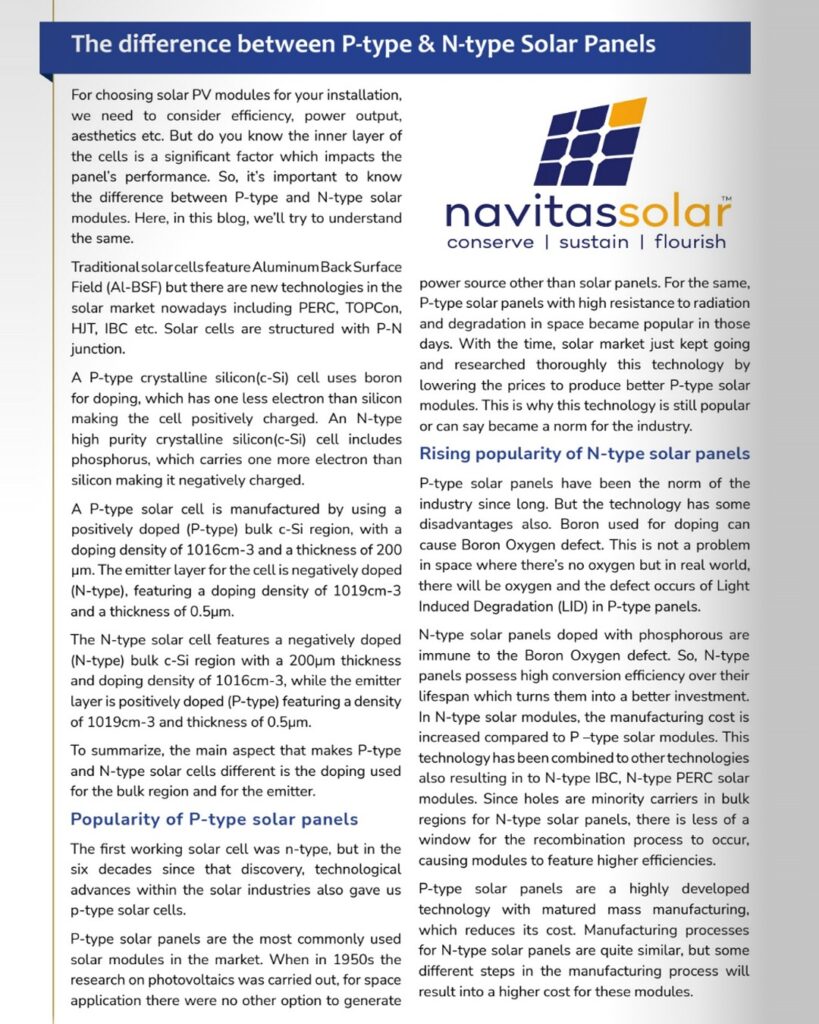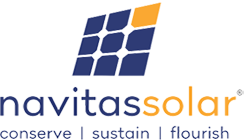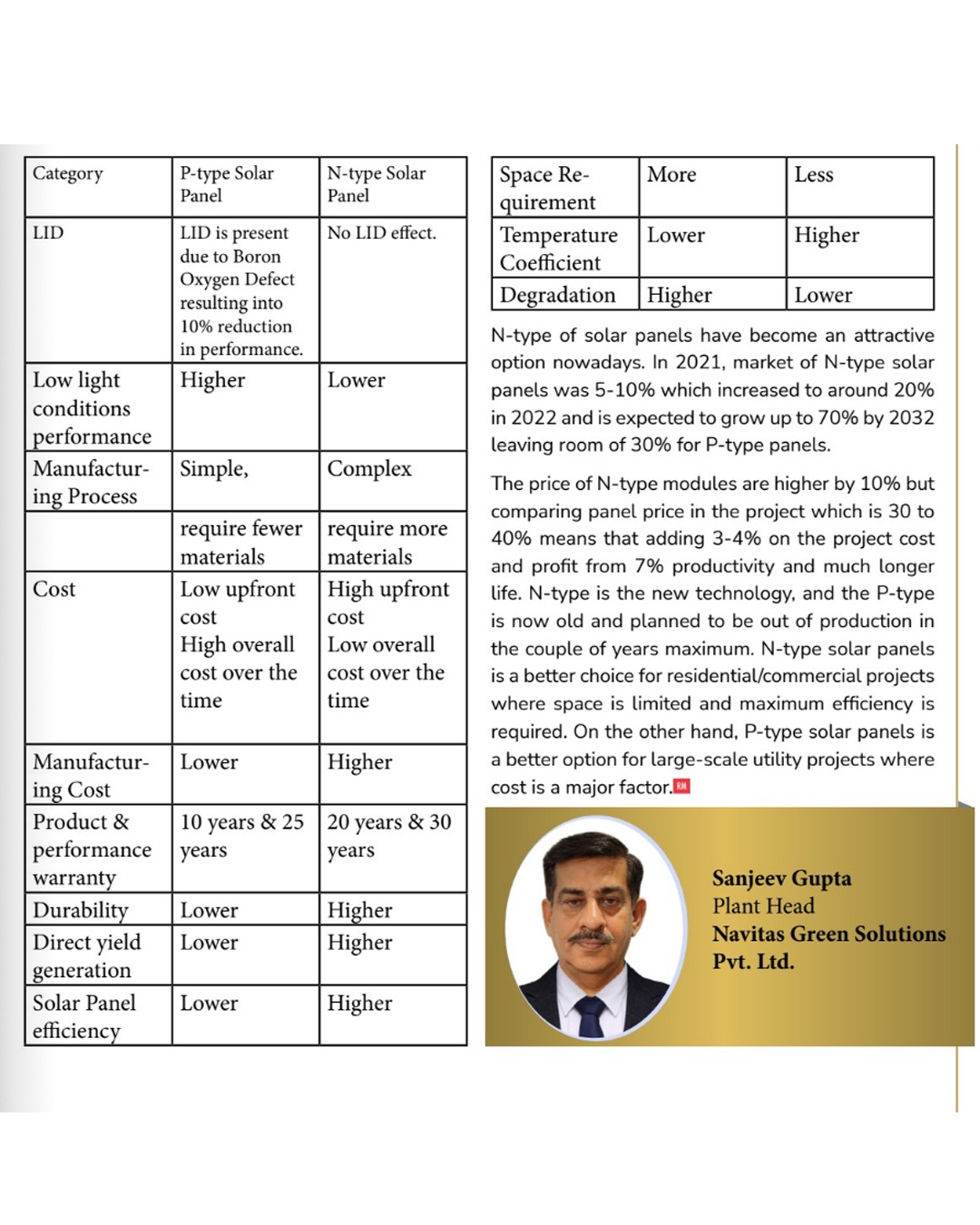Understanding P-type and N-Type Solar Panels: Expert Insights

The difference between P-type & N-type Solar Panels Mr. Sanjeev gupta, Plant Head, Navitas Solar
For choosing solar PV modules for your installation, we need to consider efficiency, power output, aesthetics etc. But do you know the inner layer of the cells is a significant factor which impacts the panel’s performance. So, it’s important to know the difference between P-type and N-type solar modules. Here, in this blog, we’ll try to understand the same.
Traditional solar cells feature Aluminum Back Surface Field (Al-BSF) but there are new technologies in the solar market nowadays including PERC, TOPCon, HJT, IBC etc. Solar cells are structured with P-N junction.
A P-type crystalline silicon(c-Si) cell uses boron for doping, which has one less electron than silicon making the cell positively charged. An N-type high purity crystalline silicon(c-Si) cell includes phosphorus, which carries one more electron than silicon making it negatively charged.
A P-type solar cell is manufactured by using a positively doped (P-type) bulk c-Si region, with a doping density of 1016cm-3 and a thickness of 200 μm. The emitter layer for the cell is negatively doped (N-type), featuring a doping density of 1019cm-3 and a thickness of 0.5μm.
The N-type solar cell features a negatively doped (N-type) bulk c-Si region with a 200μm thickness and doping density of 1016cm-3, while the emitter layer is positively doped (P-type) featuring a density of 1019cm-3 and thickness of 0.5μm.
To summarize, the main aspect that makes P-type and N-type solar cells different is the doping used for the bulk region and for the emitter.
Popularity of P-type solar panels
The first working solar cell was n-type, but in the six decades since that discovery, technological advances within the solar industries also gave us p-type solar cells.
P-type solar panels are the most commonly used solar modules in the market. When in 1950s the research on photovoltaics was carried out, for space application there were no other option to generate power source other than solar panels. For the same, P-type solar panels with high resistance to radiation and degradation in space became popular in those days. With the time, solar market just kept going and researched thoroughly this technology by lowering the prices to produce better P-type solar modules. This is why this technology is still popular or can say became a norm for the industry.
Rising popularity of N-type solar panels
P-type solar panels have been the norm of the industry since long. But the technology has some disadvantages also. Boron used for doping can cause Boron Oxygen defect. This is not a problem in space where there’s no oxygen but in real world, there will be oxygen and the defect occurs of Light Induced Degradation (LID) in P-type panels.
N-type solar panels doped with phosphorous are immune to the Boron Oxygen defect. So, N-type panels possess high conversion efficiency over their lifespan which turns them into a better investment. In N-type solar modules, the manufacturing cost is increased compared to P –type solar modules. This technology has been combined to other technologies also resulting in to N-type IBC, N-type PERC solar modules. Since holes are minority carriers in bulk regions for N-type solar panels, there is less of a window for the recombination process to occur, causing modules to feature higher efficiencies.
P-type solar panels are a highly developed technology with matured mass manufacturing, which reduces its cost. Manufacturing processes for N-type solar panels are quite similar, but some different steps in the manufacturing process will result into a higher cost for these modules.
| Category | P-type Solar Panel | N-type Solar Panel | |
|---|---|---|---|
| LID | LID is present due to Boron Oxygen Defect resulting into 10% reduction in performance. | No LID effect. | |
| Low light conditions performance | Higher | Lower | |
| Manufacturing Process | Simple, require fewer materials | Complex require more materials | |
| Cost | Low upfront cost High overall cost over the time | High upfront cost Low overall cost over the time | |
| Manufacturing Cost | Lower | Higher | |
| Product & performance warranty | 10 years & 25 years | 20 years & 30 years | |
| Durability | Lower | Higher | |
| Direct yield generation | Lower | Higher | |
| Solar Panel efficiency | Lower | Higher | |
| Space Requirement | More | More | |
| Temperature Coefficient | Lower | Higher | |
| Degradation | Higher | Lower |


 Online | Privacy policy
Online | Privacy policy
Related Posts
You May Also Like
Bonito Series: Driving Innovation in…
Read MoreTOPCon Series: The Next Generation…
Read MoreValuable Points to Remember During…
Read MoreNavitas Planet Partners with Hysolwin…
Read MoreDriving Towards a Sustainable Future:…
Read MoreWhy Do Top-Grade EVA Sheets…
Read MoreBonito Series: Driving Innovation in…
Read MoreTOPCon Series: The Next Generation…
Read MoreValuable Points to Remember During…
Read MoreNavitas Planet Partners with Hysolwin…
Read MoreDriving Towards a Sustainable Future:…
Read MoreWhy Do Top-Grade EVA Sheets…
Read MoreBonito Series: Driving Innovation in…
Read MoreTOPCon Series: The Next Generation…
Read MoreValuable Points to Remember During…
Read MoreNavitas Planet Partners with Hysolwin…
Read More